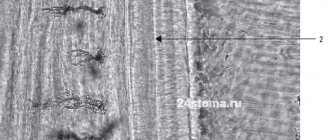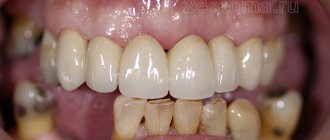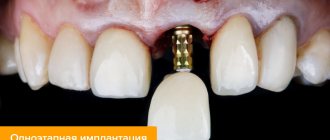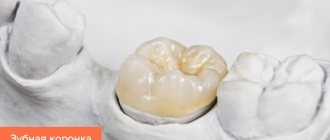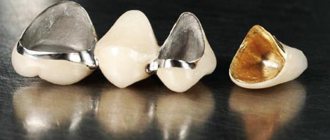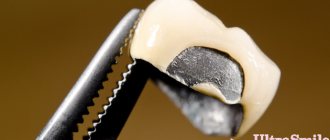Indications Installation on your teeth Materials Installation on implants What to do if the crown comes off?
How important is fixation of the tooth crown and what types of fixation are used?
In modern dentistry, preserving natural teeth is considered the most important task. For this purpose, various therapeutic and even surgical treatment methods are used. The installation of artificial crowns can be an independent method, for example, if pathological abrasion of the enamel is observed, or as part of treatment. This happens during endodontic intervention. The pulp (nerve) is removed from the tooth, it becomes brittle, and a crown is used to protect the tooth from destruction.
Indications
Indications for restoration:
- significant destruction of the coronal part;
- installation of bridges;
- pathological abrasion of enamel;
- depulpation;
- injuries.
Crowns are made of metal, ceramics and metal-ceramics. Porcelain and plastic crowns are practically not used due to their fragility. Modern materials are particularly durable and wear-resistant. They are designed for long-term use. But the service life, as well as the convenience of the crown, also depends on how well it fits and how firmly it is secured.
What is a crown and when is it installed?
A crown is a single dental prosthesis that completely replicates the visible part of the tooth. This differs from an inlay or veneer, which imitate only a fragment of a tooth. Installation of a crown is required in case of significant damage to the tooth (30% or more), when classical filling is unable to ensure proper functionality of the dental unit. A crown is also placed when a tooth is lost. In this case, the support for the prosthesis is provided by neighboring teeth or an implant that replaces the root of the lost tooth. Depending on the design features, the method of attaching the crown is selected.
Fixation of dental crowns
At certain stages of orthopedic treatment there is a need to use temporary crowns. In such cases, temporary fixation of crowns with special cement or artificial resin is used. The main feature of these materials is that the temporary structure can be removed without difficulty. Adhesive materials are easy to clean and leave no residue.
There are two types of permanent fixation of crowns in dentistry: cement and screw. With the development of implantology, they began to separate fixation on their teeth and on implants.
Operational characteristics
The degree of fixation depends on the characteristics of the temporary cement. One of its important properties is the retention force, which allows you to hold the structure and remove it if necessary. The optimal characteristics of temporary cements include:
- good adhesion of indirect restoration;
- ease of mixing and application;
- ease of removal after fixation of cement residues from prepared structures and outer surfaces of the crown;
- adequate working hours;
- optimal viscosity for comfortable use;
- easy removal of the structure without damaging nearby tissues;
- biocompatibility with abutment tooth structures and soft tissues;
- long shelf life;
- no effect on the adhesion of permanent cement.
To identify and remove excess cement, it must be radiopaque. Today, none of the temporary cements on the market have absolutely all of the above properties. It is advisable to use each of them for a specific purpose due to the lack of a single universal solution.
Installing a crown on your teeth
No matter how badly a tooth is damaged, as long as it has a root, it can be restored. How exactly the restoration is carried out depends on the degree of tooth decay. In case of minor damage, the unit is prepared - the top layer equal to the thickness of the crown is removed. Metal-ceramic crowns consist of 2 layers: metal and ceramic, so they require the deepest preparation. Ceramic crowns are thinner and remove a small layer of hard tissue. Zirconium crowns are thin and require minimal layer removal.
If the upper part is destroyed by 50% or more, then the crown is fixed with a pin. A fiberglass rod is inserted into the canal to serve as a support for the restoration.
Temporary crowns as a stage of dental prosthetics with ceramic structures
Temporary crowns as stage of prosthetics of teeth ceramic designs
I. K. Lutskaya , MD, Professor, Head of the Department of Therapeutic Dentistry of BelMAPO
N. V. Novak , MD, Associate Professor of the Department of Therapeutic Dentistry of BelMAPO
P. E. Ershov-Pavlov, private practicing dentist-orthopedist
In orthopedic dentistry, structures made from ceramics are widely used: most often these are crowns that compensate for significant tooth decay. Porcelain crowns are aesthetically pleasing, retain their shape and color, and are securely fixed to the teeth [1, 7].
Indications for their use are large defects (of carious or non-carious origin), mainly on the front teeth [3, 4].
Due to the fact that ceramic structures acquire sufficient strength, light and heat resistance with a significant thickness of their walls, it is necessary not only to prepare the enamel, but also to thin the dentin. The result of exposure is the development of increased sensitivity of the tooth to external stimuli. Another important factor is the aesthetic defect that occurs after tooth preparation. This situation is an indication for the use of a temporary crown (before making a permanent ceramic one).
The choice of color shades of ceramic masses is carried out in accordance with the requirements for a particular material [1, 5].
Adequate tooth preparation should provide a truncated cone shape [2, 7]. In this case, all surfaces are ground down by 0.8-1.5 mm: less at the neck, with an increase towards the cutting edge. In addition, a ledge is formed in the area of the clinical neck. The width of the ledge in the periodontal sulcus is from 0.8 to 1.0 mm. There should be a “gap” equal to the thickness of the crown between the occlusal surface of the antagonist and the prepared plane. Therefore, the cutting edge is formed by shortening the tooth crown optimally [2]. A significant height of an artificial crown will overestimate the bite, while a small height will reduce its strength to mechanical stress.
Since the manufacture of ceramic crowns involves a dental technical stage of work, the patient is left with prepared teeth for several days. The result may be hyperesthesia - increased sensitivity of hard tissues to temperature and chemical stimuli. A negative point is also the aesthetic defects of the dentition. To avoid these disadvantages, as a rule, during the production of permanent crowns, temporary structures are installed, which are designed for short-term isolation (from 1-3 days to 2-3 weeks, sometimes for a longer time - up to 3-6 months) of the formed and treated surface with the purpose of preventing dental hyperesthesia and ensuring aesthetics [4, 6].
The purpose of this study was to improve the quality of manufacturing temporary crowns through the use of modern dental tools and methods.
The material for the temporary structure was a self-curing “paste-paste” system based on multifunctional esters of methacrylic acid Structur 3 (VOCO), which is characterized by the positive properties of modern dental materials - it is easily inserted into the cavity due to its fluid consistency and cartridge system. It maintains a seal for the entire period it is in the tooth; indifferent to surrounding tissues; allows you to restore the anatomical shape of the tooth; It can be easily removed after its service life has expired. The material is available in eight shades to achieve natural tooth color and has natural fluorescence. It is characterized by high resistance to external influences, bending and fracture strength.
Structur 3 is indicated for the production of temporary structures (crowns, partial crowns, bridges, inlays, onlays and veneers) intended to protect prepared teeth until the production of permanent ceramic structures. They can also be used for a longer period.
To obtain a temporary crown, a cartridge with Structur 3 is installed in a mixer (type 2) from VOCO or a similar mixer gun. Before the first use, there may be a technically determined slight difference in the filling level of both cartridge cavities. In this regard, you should remove the plug from it and squeeze out the material until its exit from the two holes is uniform. After this, the mixing cannula (type 6) is installed on the cartridge and fixed by turning it 90o. The material is squeezed out when you press the mixer handle and is automatically mixed in the correct ratio. After use, the mixing cannula should be left on the cartridge. Immediately before the next use of the material, the cannula is replaced with a new one. When replacing a cannula, it is necessary to check the outlet openings of the cartridge for free flow of material.
Temporary restorations are modeled in the clinic directly in the oral cavity or in the laboratory using plaster models and impressions. Such structures are applied in the form of crowns to prepared teeth, ensuring coverage of all prepared surfaces. Temporary crowns are subject to strict requirements regarding their strength and appearance: recreating the anatomical shape of the tooth, including the contact point, is mandatory.
Since it is assumed that temporary crowns should ensure the full functioning of the dentition, including not only chewing, but also aesthetics, the rules for working with composites are followed. Namely, the shade of the material is determined, and the choice of color is carried out in optimal conditions of natural lighting, ensuring the absence of contrasting tones or colored shadows.
Restoration planning is not carried out, since the impression of the dentition reflects the basic shape, size, and relief of natural crowns. If there are defects, chips, etc. on the teeth, before taking an impression, correction of volumetric parameters can be performed using any filling materials (Fig. 1a, b).
Figure 1a. No preliminary correction of the shape of the teeth is required.
Rice. 1b. Preliminary correction of the shape of the teeth is necessary.
It is mandatory that the dentist-therapist carries out sanitation of the oral cavity and professional hygiene: removes supra- and subgingival dental plaque, prescribes anti-inflammatory therapy. Motivation and training in individual oral hygiene are provided: a toothbrush and means for high-quality treatment of the gingival area of the artificial crown are selected (Fig. 2). Mechanical oral hygiene products are represented by toothbrushes, flosses, brushes, toothpicks, stimulants, and irrigators. Currently produced electric toothbrushes combine the properties of mechanical teeth cleaning and gum massage.
Rice. 2. Using dental floss in the interdental space.
Toothpastes, gels, and liquid hygiene products have a preventive and therapeutic effect on the oral cavity. Liquid hygiene products include rinses, elixirs, balms, mouth water, mouth fresheners in the form of aerosols and deodorants, solutions, infusions, mouth rinses, liquid pastes.
Stages of making temporary crowns
Before preparing the hard tissues of the teeth, an anatomical impression is taken with silicone mass without a corrective layer (Fig. 3, 4). The impression is subsequently used to model temporary crowns (Fig. 5). The impression should be prepared by smoothing the undercuts and cutting out the outlet channels. If the thickness of the walls of the temporary structure is expected to be too small, the impression should be expanded, first of all removing the septa in the proximal spaces. The impression must then be cleaned and air dried.
Rice. 3. Impression material in the impression tray.
Rice. 4. Taking an impression in the oral cavity.
Rice. 5. An impression taken from the dentition.
Temporary crowns can also be created using a template. To do this, a splint for the entire dentition is made in the laboratory on a model in a vacuum chamber from an elastic mass. This template splint is subsequently used to model a temporary crown in it (Fig. 6a, b).
Rice. 6a. Lab-made tire: template.
Rice. 6b. Lab-made tire: on model.
After receiving the impression, the clinic prepares the teeth for ceramic crowns (Fig. 7a, b).
Rice. 7a. Prepared teeth on a model.
Rice. 7b. Prepared teeth in the oral cavity.
In accordance with the requirements for the quality of work with ceramics, replicas are removed for the manufacture of permanent crowns. An additional impression may be taken if temporary crowns are planned to be formed in the prosthetic laboratory on the model. The impressions are transferred to the dental technician to complete the required work steps.
At the clinic, the dentist begins making temporary crowns. A thin layer of glycerin is applied to the prepared teeth to prevent the material from sticking to the tooth. The inner surface of the impression (or template) must also be insulated before applying the self-curing composite.
The silicone impression or lab-made template will be filled with material to form the temporary crowns.
To mix the pastes and dispense the quantity, use a special gun and an appropriate cannula (Fig. 8). The latter is fixed on the cartridge by turning the cover clockwise until it stops. When acting on the piston of the gun, no significant force is required: the material is squeezed out evenly due to its fluid consistency. The movement of the composition stops immediately after the pressure on the piston ceases.
Rice. 8. Device and material for making temporary crowns.
Medical procedures are performed as follows. To apply Structur 3 directly into the impression, the mixer cannula is inserted into the impression in the area where the crown will be placed (Fig. 9). By moving the piston in the syringe, Structur 3 is squeezed out and, starting from the bottom, occupies the space intended for the formation of a crown. Thus, the material should first be applied to the occlusal surfaces and then fill the impressions of the teeth up to the gingival margin. To avoid the formation of air bubbles, the tip of the mixing cannula is kept immersed in the material during application. All actions are performed quickly and accurately, since the impression must be placed in the oral cavity no later than 30 seconds from the start of mixing.
Rice. 9. Filling with temporary impression material.
The form prepared in this way (impression, template) is introduced into the oral cavity and compared with the prepared teeth, using slight pressure for 30-40 seconds. The material retains its elastic consistency for 1-2 minutes. after starting mixing. The temporary structure should be removed from the oral cavity during the elastic phase, that is, within 1-2 minutes. from the beginning of mixing. After the specified time, the impression is removed along with the artificial crowns. The condition of the crowns is checked with a probe: you should make sure that the material is cured.
After 4 min. The temporary structures are removed from the impression and wiped with alcohol (for example, ethyl alcohol) to completely remove the thin oxygen-inhibited layer.
Then you need to carefully sand off the excess and roughness of the area that will be located in the gum area. If necessary, the temporary structure can be processed with a carbide cross-tooth cutter and polished by hand (for example, with a rubber polisher, fine-grit sanding disc or brush).
In cases where artificial crowns are made in the laboratory, manipulations are carried out on a model with teeth prepared for ceramic crowns using an impression or silicone template obtained earlier, before preparing the teeth (Fig. 10). Similar to the work performed in the clinic, the mixer cannula is inserted into the template and fills the space from the cutting edge to the neck of the tooth. The template is placed on the dentition under adequate pressure and removed in accordance with the time intervals specified in the instructions (depending on the ambient temperature). Temporary crowns are fitted and processed on the model (Fig. 11). Then they are removed and transferred to the clinic.
Rice. 10. Introduction of material inside the template.
Rice. 11. Temporary crowns are fitted to the model.
In the oral cavity, the prepared teeth and surrounding tissues are carefully cleaned with a gauze swab and washed with water. The remains of impression and temporary material in the periodontal sulcus and on the surface of the teeth are carefully removed. Then work continues with temporary crowns. After the composite has completely cured, the oxygen-inhibited layer is removed. Thanks to the specific properties of the material, gloss is achieved without the use of carbide polishers and polishing agents. Crowns are fitted to the teeth in the oral cavity.
To strengthen temporary structures, temporary luting cement Provicol (VOCO), which does not contain eugenol, is used, since in the future it is planned to use a composite material for permanent fixation. After cementing the crowns, you should carefully check the periodontal grooves and surrounding areas, remove any remaining temporary material and cement. Occlusal contacts are verified.
The use of temporary structures makes it possible to provide comfort for the patient during the production of permanent ceramic crowns, eliminating discomfort or the development of dental hyperesthesia. In addition, the patient has the opportunity to get used to wearing artificial prostheses (Fig. 12).
Rice. 12. Ceramic crowns in the oral cavity.
After the period of time that is optimal for the dental prosthetic stage, required for the manufacture of ceramic crowns, the temporary structures are removed. They are replaced with permanent ceramic crowns.
Conclusion
Ceramic crowns have wide indications for prosthetics of anterior teeth. Since the preparation of hard dental tissues can lead to increased sensitivity and disruption of aesthetics, and the production of permanent structures requires a certain time, temporary crowns are used for this period. Materials for such restorations must meet the requirements of aesthetics, strength, and resistance to environmental factors. They eliminate the development of hyperesthesia, providing a certain comfort for the patient, and make it easier to get used to wearing artificial prostheses. An obligatory stage of treatment is sanitation of the oral cavity, professional hygiene and patient education in rational dental care.
- Bernard T. Aesthetic dentistry and ceramic restorations: trans. from English / T. Bernard, P. Miara, D. Nathanson. - M.: Higher education and science, 2004. - 448 p.
- Kostin K. The use of digital instruments in the manufacture of a single restoration in an aesthetically significant area // Aesthetic dentistry. - 2016. - No. 1-2. — P. 108—111.
- Lutskaya I.K., Novak N.V. Ershov-Pavlov P.E. Team concept of complex restorative treatment // New in dentistry. - 2015. - No. 8 (212). - P. 46-51.
- Manak T.N., Khomich A.F., Potaneiko M.I. Planning prosthetics of the frontal group of teeth using computer modeling techniques // Dental Journal. - 2015. - No. 3. - T. XVI. - pp. 208-212.
- Hovsepyan V. A., Hovsepyan A. P. Methods of restoring the crown part of teeth using modern technologies in one visit // Cathedra (Department of Dental Education). - 2015. - No. 51. - P. 10-12.
- Miranskij A. Model within a model // New in dentistry. - 2016. - No. 4 (216). - pp. 74-81.
- Stawarczyk B., Wimmer T. Partial crowns - scientific and material science aspects // New in dentistry. - 2022. - No. 2 (222). — P. 16-29.
Stages
After preparing the surface, the orthopedist makes an impression of the jaws, from which a crown is stamped or cast in the laboratory. Manufacturing takes several days. Before installing the structure, they carry out fittings - check how it fits and whether there are any defects. The crown may be too wide, narrow, or high. Fitting helps to notice shortcomings and eliminate them.
The restoration is first placed with temporary cement. The patient is given the opportunity to get used to a foreign object in the mouth, to understand whether the height is disturbing or whether the edge is cutting the gum. Only after this the structure is installed on permanent cement.
- Before fixation, the crown is treated with a special solution, degreased and dried.
- Next, the tooth is treated with an antiseptic, and the remaining moisture is removed with ether or air. In some cases, gum retraction is performed with a thread to clearly mark the junction of the artificial crown and hard tissue.
- The components for cement are mixed on a sterile plate.
- A thin layer of cement is placed inside the restoration and placed over the tooth.
- Excess is removed. The patient is asked to sit with his teeth closed. Then clean the surfaces again and rinse your mouth with a special solution. This completes the orthopedist’s work.
Temporary dentures with one-stage implantation
In cases where the operation involves immediate loading (one-stage implantation is performed), the following options for temporary prosthetics are possible:
- Prosthetics on temporary abutments;
- Prosthetics with plastic or metal-plastic bridges.
The principle specified in the last paragraph is used when carrying out complex implantation practiced by the Healthy Smile clinic network. We are talking about the following:
- Complex implantation is performed when most or all teeth in the mouth are missing.
- The optimal number of implants is selected and the optimal places for their insertion are determined.
- Using CAD/CAM technologies, a PMMA prosthesis of the required length is manufactured, which will be installed on the installed implants.
The decision on the appropriateness of a particular method is made after analyzing diagnostic information and choosing the implantation method. You can undergo an examination and receive the necessary consultation at the clinics of the Healthy Smile network.
Materials for fixing crowns
Cement for fastening restorations must perform 2 main functions: securely fix the crown and fill the microgaps between it and the dentin. Several types of fixing materials are used in dentistry:
- Glass ionomer cements
(GIC). They are good because they have anti-caries properties and are not afraid of micro-leaks. Used for structures made of metal, with a metal base and ceramic. - Glass ionomer cements modified with composite
(GICMC). Easy to use and very durable, such materials are used for restorations made of metal, zirconium, and lithium disilicate. - Composite
. The most modern materials. They produce cements that harden as a result of a chemical reaction, light radiation and double curing. Suitable for fixing metal-ceramic, zirconium, ceramic, and lithium disilicate crowns.
All these groups are divided into numerous subgroups and the doctor selects the material for fastening based on the geometry of the tooth, crown material, and clinical case.
Dental cements have been used for a long time, they are well studied, application methods have been worked out and are simple in nature. These materials reliably fix restorations and can serve for a long time.
The disadvantages of cements are that mixing is done by hand and errors in proportions are possible. This leads to de-cementing. Excess acids negatively affect the condition of dentin.
Compound
Glass ionomer cement is a combination of powder and liquid. The powder contains fine-fractal elements of aluminum fluorosilicate glass containing silicon oxides and dioxides, metal and calcium fluorides, aluminum phosphate, radiopaque salts, as well as precious metal alloys. A copolymer solution of tartaric and carboxylic acid is used as a liquid component, providing polymerization of the composition.
Prosthetics on implants
Crowns are secured to implants in 2 ways: with cement or a screw
. This depends, first of all, on the type of implantation and the implant models that are used. But anatomical features and clinical manifestations play a big role.
Cement fixation of crowns on implants has its pros and cons. The process of attaching a restoration to an implant using cement is not much different from prosthetics on natural teeth. It is simple, well studied, and allows fixation in complex cases where a screw fixation would require enormous effort and skill.
The disadvantages include the possibility of peri-implantitis, which can be caused by excess cement. When using cement, the crown cannot be repaired, only replaced.
Screw fixation of crowns to the implant prevents cement from getting on the tissue. There is a possibility of repair and correction. The results of joining metal to metal without a cement layer are better. The single design of abutment and crown reduces the risk of infection.
However, the fitting of a screw-fixed prosthesis is more delicate, requires certain skills, and the price of designs with screws is higher.
This is why choosing a doctor is so important. A qualified implantologist takes into account dozens of details before choosing an implantation method, which determines whether the crown will be screw-fixed or cemented, and an experienced orthopedist knows how to work with both.
Immediate dentures (butterfly dentures)
Immediate dentures are removable temporary orthopedic structures, the name of which indicates “urgent” use (initially - to replace an extracted tooth).
The nickname “butterfly” is due to its appearance: the fastening elements, with their outlines, resemble the wings of a butterfly. In fact, with the help of these elements, the prosthesis is fixed in the mouth (as if it clings to neighboring teeth).
Butterfly prostheses are made from different materials, most often from nylon. Such structures are elastic, quite reliable, have high aesthetic values, and do not compress the gums (like acrylic ones). However, such prostheses are short-lived, so they are used as a temporary solution. Sometimes “butterflies” are used as an alternative to permanent dentures or solutions related to implantation in adolescents, since the dental system is not yet fully formed.
At the discretion of the doctor, a butterfly prosthesis can be installed as a way to replace missing teeth during the period of implant healing.
Indications for using the cement fixation method
Factors that determine the advisability of using an adhesive include:
- Complete or partial dentition;
- Local restoration of problem areas;
- Angulation of implants, limiting the functionality and aesthetics of prostheses;
- Using several structures with a non-parallel slope at once;
- Patient's wishes.
It should be taken into account that the implementation of the protocol in question is possible only if a number of requirements are met:
- The height of the upper part of the fastening must be at least 5 mm;
- The gum tissue surrounding the structure should be 3-5 mm long;
- The volume of the bone wall around the implant is from 2.5 mm;
- The ratio of the crown and the body of the rod is 1 to 1.5;
- The antagonist elements have the correct anatomical position.
Compliance of the indications is determined during the preliminary examination. The presence of deviations necessitates the selection of an alternative orthopedic protocol.
Conclusion: what to choose?
Based on the results of everything said above, we can conclude that there is no ideal method of fixing crowns, but the optimal one will be the one that best suits a particular patient, provided that it is chosen by a professional based on objective factors. In addition, competent and careful adherence by the orthopedist to the technology will help mitigate any shortcomings and avoid negative consequences.
The VivaDent dental clinic employs just such professional dentists - qualified, experienced and competent, which means that no matter how the crowns are installed on your implants, it will be implemented flawlessly.
Partial removable structures
If several units are missing in a row and it is impossible to make an implantation, partial removable dental prosthetics are used. The following structures can be used for this:
- Lamellar. They are fixed on the supporting teeth with metal hooks.
- Clasp on a metal frame. Such dentures are attached in three ways - on clasps, attachments or telescopic crowns.
- Quadrotti clasp plastic systems (QuattroTi). Fixation is carried out on the supporting teeth with aesthetic clasps made of durable polymer material Dental-D.
- Sandwich dentures. These structures are literally placed over the supporting teeth using large, hollow crowns.



